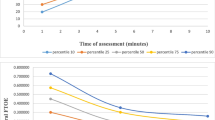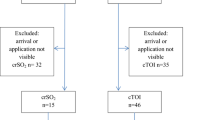Abstract
Introduction
Near-infrared spectroscopy (NIRS) was used to monitor intraoperative regional oxygen saturation (rSO2) during open (Op) and minimally invasive (MI) surgery performed in neonates (N) and children.
Materials and methods
NIRS sensors were applied to the forehead and flanks for cerebral rSO2 (C-rSO2) and renal rSO2 (R-rSO2), respectively. MI included laparoscopy (La), retroperitoneoscopy (Re) and thoracoscopy (Th). In children, Op and MI were major operations taking at least 3 h (MOp; MMI). Pathological desaturation (PD) was defined as > 20% deterioration in rSO2.
Results
Mean ages at surgery were N: 5.2 ± 8.2 days, MOp: 2.4 ± 2.9 years, and MMI: 3.8 ± 4.3 years. Despite significantly shorter operative times in N (169 ± 94 min; p < 0.0001), PD was significantly worse; PD(C-rSO2): N = 14/35 (40.0%) versus MOp = 3/36 (8.3%) and MMI = 7/58 (12.1%); p = 0.0006, and PD(R-rSO2): N = 27/35 (77.1%) versus MOp = 6/36 (16.7%) and MMI = 7/58 (12.1%); p < 0.0001, respectively. PD(R-rSO2) occurred immediately with visceral reduction in NOp (Fig. 1) and PD was frequent during NMI(Th) (Fig. 2). rSO2 was stable throughout MOp and MMI (Fig. 3).

Pathological desaturation in renal rSO2 after visceral reduction for gastroschisis. Renal rSO2 deteriorated immediately after viscera were returned to the abdominal cavity rSO2 regional oxygen saturation

Fragility of tissue perfusion during thoracoscopic lung lobectomy in a neonate. Pathological desaturation occurred frequently during neonatal thoracoscopic surgery rSO2 regional oxygen saturation

Changes in cerebral and renal rSO2 according to operative time. Cerebral and renal rSO2 did not appear to change according to operative time during major open and major minimally invasive surgery in children. rSO2 regional oxygen saturation
Conclusions
NIRS is a non-invasive technique for monitoring rSO2 as an indicator of intraoperative stress and vascular perfusion. PD was so significant in neonates that intraoperative NIRS is highly recommended during thoracoscopy and procedures requiring visceral manipulation.
Similar content being viewed by others
References
Westgarth-Taylor C, de Lijster L, van Bogerijen G, Millar AJ, Karpelowsky J (2013) A prospective assessment of renal oxygenation in children undergoing laparoscopy using near-infrared spectroscopy. Surg Endosc 27(10):3696–704. https://doi.org/10.1007/s00464-013-2950-3
Bishay M, Giacomello L, Retrosi G, Thyoka M, Garriboli M, Brierley J et al (2013) Hypercapnia and acidosis during open and thoracoscopic repair of congenital diaphragmatic hernia and esophageal atresia: results of a pilot randomized controlled trial. Ann Surg 258(6):895–900. https://doi.org/10.1097/sla.0b013e31828fab55
Ellinas H, Seefelder C (2010) Congenital diaphragmatic hernia repair in neonates: is thoracoscopy feasible? Paediatr Anaesth 20(10):967–9. https://doi.org/10.1111/j.1460-9592.2010.03384.x
Lindberg F, Bergqvist D, Björck M, Rasmussen I (2003) Renal hemodynamics during carbon dioxide pneumoperitoneum: an experimental study in pigs. Surg Endosc 17(3):480–4. https://doi.org/10.1007/s00464-002-9044-y
Demyttenaere S, Feldman LS, Fried GM (2007) Effect of pneumoperitoneum on renal perfusion and function: a systematic review. Surg Endosc 21(2):152–60. https://doi.org/10.1007/s00464-006-0250-x
Costerus S, Vlot J, van Rosmalen J, Wijnen R, Weber F (2019) Effects of neonatal thoracoscopic surgery on tissue oxygenation: a pilot study on (Neuro) Monitoring and outcomes. Eur J Pediatr Surg Off J Austrian Assoc Pediatr Surg [et al] = Z fur Kinderchir 29(2):166–72. https://doi.org/10.1055/s-0037-1615277
Beck J, Loron G, Masson C, Poli-Merol ML, Guyot E, Guillot C et al (2017) Monitoring cerebral and renal oxygenation status during neonatal digestive surgeries using near infrared spectroscopy. Front Pediatr 5:140. https://doi.org/10.3389/fped.2017.00140
Steppan J, Hogue CW Jr (2014) Cerebral and tissue oximetry. Best Pract Res Clin Anaesthesiol 28(4):429–39. https://doi.org/10.1016/j.bpa.2014.09.002
Hamrin TH, Radell PJ, Fläring U, Berner J, Eksborg S (2018) Performance of regional oxygen saturation monitoring by near-infrared spectroscopy (NIRS) in pediatric inter-hospital transports with special reference to air ambulance transports: a methodological study. J Clin Monit Comput 32(5):841–7. https://doi.org/10.1007/s10877-017-0094-z
Marin T, Moore J (2011) Understanding near-infrared spectroscopy. Adv Neonatal Care 11(6):382–8. https://doi.org/10.1097/anc.0b013e3182337ebb
Toet MC, Lemmers PM, van Schelven LJ, van Bel F (2006) Cerebral oxygenation and electrical activity after birth asphyxia: their relation to outcome. Pediatrics 117(2):333–9. https://doi.org/10.1542/peds.2005-0987
Kussman BD, Wypij D, Laussen PC, Soul JS, Bellinger DC, DiNardo JA et al (2010) Relationship of intraoperative cerebral oxygen saturation to neurodevelopmental outcome and brain magnetic resonance imaging at 1 year of age in infants undergoing biventricular repair. Circulation. 122(3):245–54. https://doi.org/10.1161/circulationaha.109.902338
Hoffman GM, Brosig CL, Mussatto KA, Tweddell JS, Ghanayem NS (2013) Perioperative cerebral oxygen saturation in neonates with hypoplastic left heart syndrome and childhood neurodevelopmental outcome. J Thorac Cardiovasc Surg 146(5):1153–64. https://doi.org/10.1016/j.jtcvs.2012.12.060
Austin EH 3rd, Edmonds HL Jr, Auden SM, Seremet V, Niznik G, Sehic A et al (1997) Benefit of neurophysiologic monitoring for pediatric cardiac surgery. J Thorac Cardiovasc Surg. 114(5):707–15. https://doi.org/10.1016/s0022-5223(97)70074-6 (17; discussion 15-6)
Eichhorn L, Erdfelder F, Kessler F, Doerner J, Thudium MO, Meyer R et al (2015) Evaluation of near-infrared spectroscopy under apnea-dependent hypoxia in humans. J Clin Monit Comput 29(6):749–57. https://doi.org/10.1007/s10877-015-9662-2
Pelizzo G, Bernardi L, Carlini V, Pasqua N, Mencherini S, Maggio G et al (2017) Laparoscopy in children and its impact on brain oxygenation during routine inguinal hernia repair. J Minim Access Surg 13(1):51–6. https://doi.org/10.4103/0972-9941.181800
Tytgat SH, Stolwijk LJ, Keunen K, Milstein DM, Lemmers PM, van der Zee DC (2015) Brain oxygenation during laparoscopic correction of hypertrophic pyloric stenosis. J laparoendosc Adv Surg Tech Part A 25(4):352–7. https://doi.org/10.1089/lap.2014.0592
Bishay M, Giacomello L, Retrosi G, Thyoka M, Nah SA, McHoney M et al (2011) Decreased cerebral oxygen saturation during thoracoscopic repair of congenital diaphragmatic hernia and esophageal atresia in infants. J Pediatr Surg 46(1):47–51. https://doi.org/10.1016/j.jpedsurg.2010.09.062
Newcombe J, Mathur M, Ejike JC (2012) Abdominal compartment syndrome in children. Crit Care Nurse 32(6):51–61. https://doi.org/10.4037/ccn2012761
Author information
Authors and Affiliations
Corresponding author
Additional information
Publisher's Note
Springer Nature remains neutral with regard to jurisdictional claims in published maps and institutional affiliations.
Rights and permissions
About this article
Cite this article
Miyake, Y., Seo, S., Kataoka, K. et al. Significant neonatal intraoperative cerebral and renal oxygen desaturation identified with near-infrared spectroscopy. Pediatr Surg Int 38, 737–742 (2022). https://doi.org/10.1007/s00383-022-05102-5
Accepted:
Published:
Issue Date:
DOI: https://doi.org/10.1007/s00383-022-05102-5




